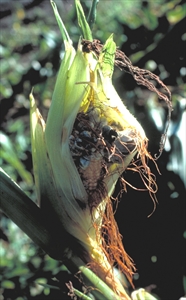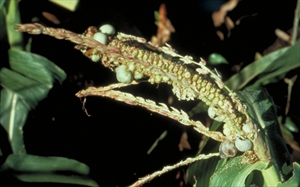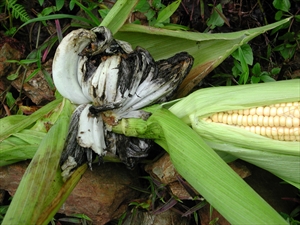Boil smut, common smut of maize
Pacific Pests, Pathogens and Weeds - Online edition
Pacific Pests, Pathogens & Weeds
Maize boil smut (046)
Ustilago zeae; previously known as Ustilago maydis
Asia, Africa, North, South and Central America, the Caribbean, Europe, Oceania. It is recorded from Australia, American Samoa, Fiji, New Zealand, Papua New Guinea, and Solomon Islands.
Maize, sweet corn.
The fungus infects all the aboveground parts, especially young growing tissues. Systemic infection occurs in seedlings; after they are infected, the fungus grows inside them. Infection is increased by injury to the plants, such as those that occur during cultivation.
Infection results in the maize fruit - the ear - becoming distorted. The seeds swell with enlarged plant cells containing fungal threads and masses of spores (Photos 1-3). Other parts of the plant - leaves and stems - are also susceptible to infection, but less so (Photo 4).
Boil smut is a soil borne disease. The spores ('teliospores') remain alive in the soil for many years. They germinate and produce a second type of spore ('sporidia'); these are the spores that infect maize. They are carried on the wind or splashed by water onto young maize plants. The spores germinate, infect, and cause the plant cells to multiply, enlarge and form galls.
Galls filled with black spores form on leaves, stalks, ear and tassels. They grow to 15 cm on the ears, but those on the leaves are smaller, 6-12 mm, become hard and dry, and produce few spores. The galls on the ears are at first enclosed in a white to light grey covering, before splitting to release dark brown to black spores. One gall may produce 200 billion spores!
Smut spores contaminate maize seeds, and this is the way that the fungus is introduced to new areas. The spores can also be spread on machinery, people, livestock and fodder.
Early infection results in stunted plants and even death, although this is uncommon. Overall, boil smut is a minor disease of maize and sweet corn in Fiji and Solomon Islands. The disease has been present in Solomon Islands for nearly 30 years, but the number of plants infected in any crop remains low. Presumably, this is because conditions do not favour the disease, the crop is not grown in the same land one year after another, or the varieties grown have some resistance to infection.
Note, in Mexico, maize smut, known as 'huitlacoche', is eaten. The galls are harvested while still young, and when cooked have a mushroom-like flavour.
Look for smut galls on leaves, stalks, ears or tassels. Galls are firm initially, white or grey, later bursting to release the black powdery spores. Severely infected plants may be stunted.
CULTURAL CONTROL
Cultural control is important. The following should be done:
Before planting:
- Do not replant maize in land where the disease was present previously.
During growth:
- Remove infected plants before the galls rupture, and burn the plants.
- Avoid over-fertilizing with nitrogen, as this increases susceptibility.
- Be careful not to injure the plants during cultural operations.
After harvest:
- Collect all the stalks and leaves after harvest and burn them.
RESISTANT VARIETIES
There appears to be good field resistance to boil smut in the varieties grown in Fiji and Solomon Islands, as the percentage infection is low. Sweet corn varieties are more susceptible, but the disease is not common in them either.
CHEMICAL CONTROL
In Australia, seed is treated with the fungicide, carboxin (Vitavax) and thiram before planting.
____________________
When using a pesticide, always wear protective clothing and follow the instructions on the product label, such as dosage, timing of application, and pre-harvest interval. Recommendations will vary with the crop and system of cultivation. Expert advice on the most appropriate pesticide to use should always be sought from local agricultural authorities.
AUTHORS Helen Tsatsia & Grahame Jackson
Photo 4 David Cohen Flickr. (https://www.flickr.com/photos/drcohen/1913163221/in/faves-44747158@N03).
Produced with support from the Australian Centre for International Agricultural Research under project PC/2010/090: Strengthening integrated crop management research in the Pacific Islands in support of sustainable intensification of high-value crop production, implemented by the University of Queensland and the Secretariat of the Pacific Community.







